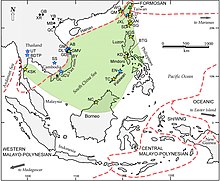
Back Kebudayaan giok Filipina ID ഫിലിപ്പീൻ ജേഡ് സംസ്കാരം Malayalam Kulturang batong-lungtian ng Pilipinas Tagalog Нефритова культура Ukrainian 東南亞史前臺灣玉器的流動 Chinese
 | |
| Geographical range | Batanes, Luzon and Palawan areas |
|---|---|
| Period | late Neolithic to early iron Age |
| Dates | c. 2000 BC – c. 1000 AD |
| Preceded by | Tabon people Austronesian expansion Ancient barangays |
| Followed by | History of the Philippines (900–1565) |


Philippine jade culture, or jade artifacts, made from white and green nephrite and dating as far back as 2000–1500 BC, have been discovered at a number of archaeological excavations in the Philippines since the 1930s. The artifacts have been both tools like chisels and ornaments such as lingling-o earrings, bracelets, and beads.
The green nephrite has been traced to a deposit near modern Hualien City in eastern Taiwan. The source of the white nephrite is unknown. The jade was worked in the Philippines, especially in Batanes, Luzon, and Palawan. Some was also processed in Vietnam, while the peoples of Malaysia, Brunei, Singapore, Thailand, Indonesia, and Cambodia also participated in one of the most extensive sea-based trade networks of a single geological material in the prehistoric world. It was in existence for at least 3,000 years, where its peak production was from 2000 BC to 500 AD, older than the Silk Road in mainland Eurasia or the Maritime Silk Road. It began to wane during its final centuries, from 500 AD until 1000 AD.[1][2][3][4]
- ^ Tsang, Cheng-hwa (2000), "Recent advances in the Iron Age archaeology of Taiwan", Bulletin of the Indo-Pacific Prehistory Association, 20: 153–158, doi:10.7152/bippa.v20i0.11751
- ^ Turton, M. (2021). Notes from central Taiwan: Our brother to the south. Taiwan's relations with the Philippines date back millenia, so it's a mystery that it's not the jewel in the crown of the New Southbound Policy. Taiwan Times.
- ^ Everington, K. (2017). Birthplace of Austronesians is Taiwan, capital was Taitung: Scholar. Taiwan News.
- ^ Bellwood, P., H. Hung, H., Lizuka, Y. (2011). Taiwan Jade in the Philippines: 3,000 Years of Trade and Long-distance Interaction. Semantic Scholar.